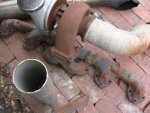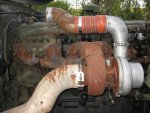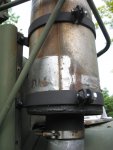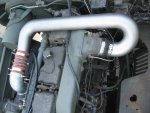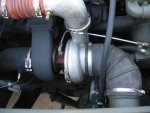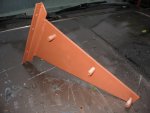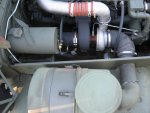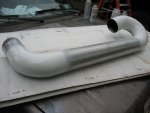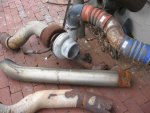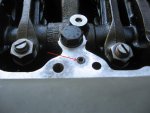I agree. Also, thanks jwaller for thread and pioneering work. Here is some stuff I got from a truck repair shop across street from where I work. Manifold looks different than yours. Came out of a N14 powered twin screw commercial tractor. Donor engine's data plate was gone. Mechanic said rig ran 36psi. Truck had an air to air intercooler and Jake brake, which I did not take. Mechanic said timing was 19* and set by gasket thickness on cam followers. This is same as the NHC250 (TM 9-2320-260-34-1, page 3-234)
I had to glass bead the compressor wheel and housing. It was full of AL2O3 and the wheel had spots. Wheel was independently balanced and slides right off. Comp wheel looks like the 'D' but bigger. Went to Cummings for some bits. Parts guy there said something like, "don't do it". LOL . Must have wanted to sell me a new Sig 600 or the likes. Looks like there is a nice route for intake duct over frt end of rear valve cover. I'll weld up some pipe to connect to the intake manifold inlet. Air filter and hose looks like it will line up when on the right fender.
Got some junk 5" mufflers and stack end out of dumpster(s) at work. Turbo outlet pipe was swapped from pictured . More junk, now using one off a Mack. Muffler looks too big in pic but ok from ground/frt and side. Muffler outlet height is about same as hardtop at 8'10" tall. Stack end, now shown , is removable and adds 14". There is a slip joint halfway between turbo and muffler. The Chassis Shop had a 4" donut that will can make the tight 210* pipe U turn in a 12" width (cost $90). ipgparts.com had the silicone 4"-5" cone coupler and t-bolt clamps. (~$50). Horn was moved and needed a longer tube and wires. Surge tank is now mounted on firewall at the original height. The pipe on bottom tolerated being bent down a bit to point more away from turbo.. Coolant lines are longer so they will not be next to the turbo. I add coolant filters to everything. Access to filter is excellent with inner panel removed. A rear inner fender panel will need to be made.
My project updates will be moved to this post instead of later in the thread.
------------6-21-09----------------
Updated pictures of muffler. It is now painted F/B and has its stack. The new camera angle makes it look smaller. Side panel does not open due to air filter but I trimmed the hinge pins and it will detach by moving forward and lifting it up. Air filter-to-turbo pipe is the old one, shortened about 6" then shimmed up to 5-1/2" OD on one end. It could be a straight shot but that would have weaken the side panel a lot.
------------7-27-09--------------
I don't plan to get greedy. Target is 12psi +/-2psi. That may be as high as you want to go with no intercooling. 15.8:1 pistons should be ok here but more boost might require a piston change (Cumming did this with each HP increase. see Pitt Diesel article below). Haven't got to my road test yet but makes 5.5psi at 2100 (no load). No smoke to speak of during that, but no load isn't going to say much. I'll have my gauges installed soon.
-------------8-29-09------road test results--------------
no load -
5.5psi at 2100rpm
6 psi at 2200
under load (up hill)
7 psi at 1300
9 psi at 1400
10 psi at 1500
11 psi at 1600
12 psi at 1700
13 psi at 1800
14 psi at 1900
15 psi at 2000
15.5 psi at 2050
16 psi at 2100
Ambient temp 62*F
Turbo whistles off idle, though not loudly. It feels a bit stronger than before. Maybe 40HP? It's hard to say because I had only driven it 100 miles before adding the turbo. I also didn't go far enough to warm the drivetrain. Not much smoke
---------------8-30-09--------------
I think turbo I got is the series 3 w/map width enhanced compressor housing. That is from memory, after once glancing at G-force's Pitt Diesel Power link. Link doesn't seem to work now. Looks like the site had a makeover. I'll look for articles later. Happy about the psi. Could have been wildly high or low. Increase is very linear and rpm dependent, just like the LD[T]465. I was hoping for a faster manifold press rise to help span the gear shift jump. Guess I'm too used to commercial EM7 Mack fast t rise. Seems to wake up at 7 or 8 psi. Still have some HP ideas. Some newer big rigs use air shift clutch fan... Muffler is fantastic. Sorry Westech, it will stay on for a while. Kind of hate to lose the low profile w/glass down aspect but...Not too many bugs left. Prob do it up OD-SG. Sure is fun to play/work on.
ps-
I think this is the working link (Originally posted by G-force)
www.pittsburghpower.com/support/viewtopic.php?f=7&t=110&sid=bd47e2330476743b8c3339da73d00c53
Here is page 1 of the index, w/many of interesting topics
www.pittsburghpower.com/support/viewforum.php?f=7&sid=21e5c83ac6b6c65d5c09ca3b16ce8b40
more links
www.pittsburghpower.com/support/
--------------9-20-09 ----------------------
pulls to R/L quickly up smaller hills in CNY. I don't think I can hurt it much as it is set, maybe helping more by keeping EGT lower w/turbo. No smoke so potential for bit more w/o intercooling . I will be happy if I keep old perf. with bigger tires/weight of winch. Prefer to fuss with bad window regs and door latches first. Will tow at max rating (30K) next year with the reduced mech. advantage of the bigger tires. Will be nice to slow engine down at 50 and 55.
----------------11-1-10-------------
Better power, lower EGTs, quiet. 700 post probe is pretty typical. Local dyno service was $400, which is more than I want to spend. Coolant lines were swapped in spring. The pic below has incorrect flow thru filter.
------------------6-2011--------------
Turned up fuel pressure 1/2 turn (throttle shaft screw). Seemed to be a bit stronger though manifold pressures stayed the same, except 1 psi higher at bottom of operating range (~1300-1400).
EGT typically a steady 600*F (post probe) including continuous wot towing 28,000, ambient temp 80*F. Saw it briefly at 700*F (reduced rpm/boost) but would go no higher.
Road speed is about 55 mph(indicated) at 2000rpm w/super singles, 60 mph at 2100 which I try to avoid. Very easy to maintain 55 on flat roads or small hills on interstates (towing). Bigger hills 45. Bigger 35. Not been up really big ones. Low end power could still be better. A little sluggish getting up to speed from a dead stop (w/load), especially uphill. Cruising at 55 the manifold pressure is a steady 10psi. It is definitively a whistler. Muffler is nice. Still a lot of mechanical noise in cab.The plan to turn it up another 1/2 turn and check rail pressure. Check the speedo w/gps too.
------------------------7-6-211------------
After a hard pull I noticed some new blowby. I recall fittings on each rocker box, then remembered G-Force's comment on passageway that need to be plugged. Did a quick check with some wire. These passages goes straight into the intake ports. They are not used on the turbo motors. I pulled out the steel insert w/vise-grips and plugged them holes with 5/16x24 set screws (w/red Locktite). I used grease in the flutes, cleaning it after every turn after tap got it started. The first one I had a bit of paper towel low in hole. I extracted it with straightened fish hook and saw almost no metal. Plugging these added about 1psi manifold pressure at 2000rpm
---------------------8-13-2011---------------
Fuel pump stuff
http://www.steelsoldiers.com/5-ton-up/73444-nhc250-cummins-fuel-rail-pressure.html
-----------9-9-2011-----------
I put in a #20 button last week (was #27). Went 200miles today. Towed load was 28,000lbs. Ambient temp about 80*F. Had some large hills south of Syracuse and northern Pa (20-30mph). Highest temp was 775*F (post probe). The button change raised peak EGT but not a lot, maybe 75*F. Towing on flat terrain EGT was about same as before, 600-700*F. The button change added 2 psi- maybe 18psi at 2100rpm, 16psi at 2000, 15psi at 1900. Fuel press is 225lb/sq in at 2100. The throttle shaft scew got 1-1/4 turns too. Overall not a huge power increase. Maybe 10%. Might try the #17 in a week or two.
ps- I expected the highest EGT temp at low rpm but it was highest at higher rpms. That may be because I'm getting cool air at low rpm and hot air at high rpm (higher boost/ higher intake charge temp/ no intercooler...)


